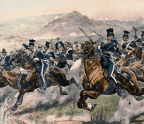MANY WATERS TO CROSS


Trudging across the frozen New Jersey countryside in the winter of 1776–77, the armed Americans resembled a mob more than an organized military force. They camped in snow-covered fields without benefit of tents or blankets, and while on the march they were beset by high rates of desertion and an overall aura of exhaustion. The American commander was all too familiar with such straits. Though a combat veteran and personally courageous, Gen. George Washington had participated in more noble defeats than glorious victories. Indeed, in 1775 when Congress had appointed him to command the fledgling Continental Army, a contemporary pointed out that while Washington was a decent man, he’d lost every major battle in which he’d participated during the 1754–63 French and Indian War.
In late December 1776 Washington’s main concern was to distance his ragtag force from the enemy, and so the Army marched on. On the night of December 25–26 he had directed his men on what was intended to have been a coordinated three-pronged assault across the Delaware River against Trenton. As events turned out, two of his three attacking columns never made it across the river, the planned broad advance turning into a narrow, single-column crossing. While Washington had prevailed at Trenton, days later when he’d ordered a subordinate to delay the British advance, the officer had instead abandoned his men and left the field. That same day the Army had found itself in a defensive position so tenuous the enemy commander had gloated he would “bag” the Americans the next day. And during a desperate nighttime movement from that position, more than 1,000 Americans had panicked and fled without firing a shot.
Despite such setbacks, by New Year’s Day 1777 the Army had finally reached a position
You’re reading a preview, subscribe to read more.
Start your free 30 days



